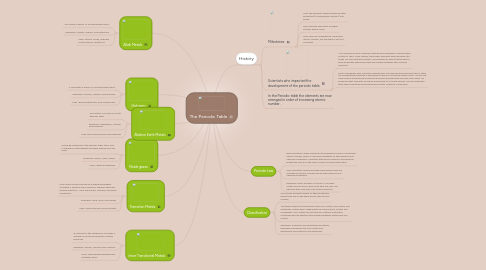
1. Noble gases
1.1. Group 8A elements in the periodic table; the S and P sublevels of the highest occupied energy level are filled
1.2. Examples: Xenon, Neon, Argon
1.3. Uses: Lights and welding
2. Alkali Metals
2.1. Any metal in group 1A of the periodic table.
2.2. Examples: Lithium, sodium, and potassium
2.3. Uses: Atomic clocks, and help control bipolar symptoms
3. Halogens
3.1. A nonmetal in group 7A of the periodic table.
3.2. Examples: Fluorine, chlorine, and bromine
3.3. Uses: Blood substitutes, and iodized salts
4. Transition Metals
4.1. One of the Group B elements in which the highest occupied S sublevel and a nearby D sublevel generally contain electrons. Most are ductile, mallable, and good conductors.
4.2. Examples: Gold, silver, and copper
4.3. Uses: Sunscreen and micronutrients
5. Alkaline Earth Metals
5.1. Any metals in Group 2A of the periodic table.
5.2. Examples: Magnesium, calcium and fireworks
5.3. Uses: Build strong bones and fireworks
6. Inner Transitional Metals
6.1. an element in the lanthanicle or nearby F sublevel of its atoms generally contain electrons
6.2. Examples: Cerium, Thorium and Uranium
6.3. Uses: Glass welding goggles and synthetic gyms
7. History
7.1. Milestones
7.1.1. First, the elements were grouped by their properties (a classification system) into triads.
7.1.2. The elements were then arranged by their atomic mass
7.1.3. Now, they are organized by increasing atomic number, but the table is still not complete.
7.2. Scientists who impacted the development of the periodic table
7.2.1. J.W. Dobereiner, was a German chemist who published a classification system in 1829. In his system, the known elements were grouped into triads. He also noticed a pattern. One element in each triad tended to have properties with values that fell midway between two of those elements.
7.2.2. Dmitri Mendeleev was a Russian chemist who also developed a periodic table in 1869. He arranged the elements in his periodic table by increasing atomic mass. He also left blank spaces because he know that Bromine belonged with Chlorine and Iodine. He predicted that elements would be discovered to fill those spaces. Also he predicted what their properties would be based on their locations in the table.
